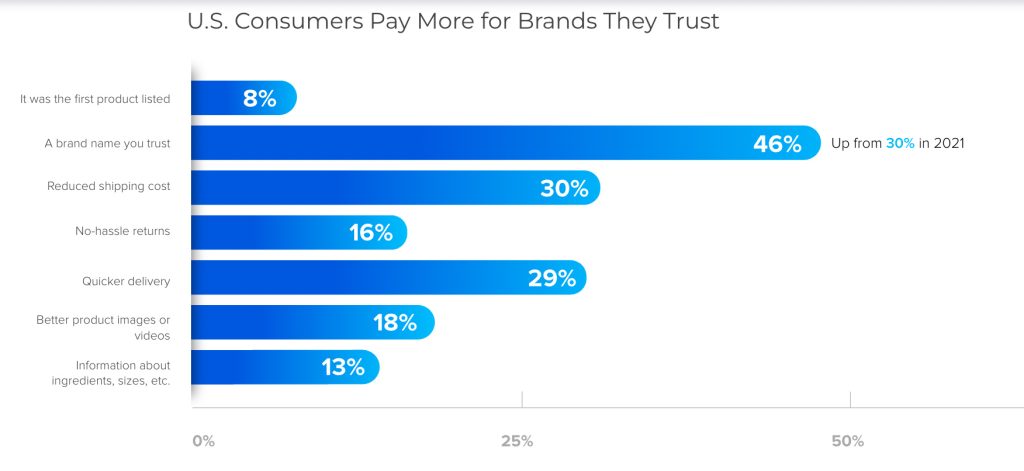There are several benefits of doing a brand analysis.
For starters – it can help you identify weak spots in your brand strategy. It can increase the efficiency of your branding and marketing campaigns. And most importantly, it gives you a detailed view of how your brand looks to the world.
💡 Read Brand Reputation 101: Monitoring, Analysis, and Management Tools
Performing an effective brand analysis includes:
- Affirming branding goals and objectives.
- Collecting internal feedback.
- Analyzing competitors.
- Evaluating market perception.
- Creating a company summary.
In this blog, we’ll go through all of these in detail.
Let’s start!
6 Steps of Brand Analysis
#1 Create an analysis framework
Think of a brand analysis as cultivating the personality of a brand.
The first logical step is to have a complete framework of procedures and regulations, as well as the company’s strategic goals and values.
Such a framework should include:
- The company’s operational scope.
- Products or services the company offers.
- Internal and business-related values.
- Target market or intended audience.
- Distribution channels for the branding content.
- Any product related information such as pricing and specs.
This will help the branding stakeholders identify the areas that need improvement. It will also give them a clear process that they can replicate again and again.
Read What is Brand Equity and Why It Matters
#2 Get audience feedback
Around 88% of consumers say brand authenticity is important when making a buying decision. And 54% of PR professionals expect authenticity and transparency to remain one of the top trends in the next year.
Authenticity is just one of the factors that go into a purchase decision. This makes it even more important to listen to customers when doing a brand analysis.
Their experience is directly related to how well you’re communicating your brand values to them. Creating a great product is one way to do this. However, nothing says you listen to the customers more than directly asking for their feedback.
About 46% of U.S. consumers say that they don’t mind paying more for brands they can trust.

Asking for their opinion about branding and business performance may be a good way to build this trust.
Read Sentiment Tracking: How to Get Inside Your Customers’ Minds?
#3 Implement social listening
Discussions about a brand on social media are a great indicator of success (or failure).
To that end, it’s necessary to have a robust social listening element in your analysis framework.
Through effective social listening, you can:
- Pinpoint the pain points.
- Gather highly actionable insight.
- Analyze specific brand performance indicators.
- Recognize future marketing opportunities.
One important thing to note is that social listening is different from “social monitoring.” The latter is a targeted approach that focuses on a single campaign or keyword cluster.
Social listening is much broader and all-encompassing. It provides an overarching view of the brand’s image in the public eye. This increases the amount of data you can analyze, letting you make smarter brand decisions.

#4 Evaluate marketing effectiveness
Your marketing efforts are the backbone of your brand strategy. This is why it’s a good idea to evaluate their effectiveness early on.
Do an in-depth analysis of the following:
- Marketing materials you put out.
- Assets you created.
- Content you distributed across social channels to drive sales.
Then determine the level of consistency of your marketing efforts and the overall quality of your marketing.
An effective evaluation would consist of questions such as:
- Do the marketing assets align with the brand’s voice and values?
- Do the colors and visual cues reflect what the brand stands for?
- Is the brand voice accurate to how the brand wants to present itself?
- Are all the brand’s design elements consistent across all channels?
- Is the brand staying true to the vision of the founders and the expectations of the audience?
#4 Analyze website and social media traffic

Every brand strategy should be based on a set number of marketing channels from which to advertise the brand.
Your website traffic is a good indicator of which marketing channels are working well. It also indicates which ones are failing to produce the impact that they should. From there, you have two options. You could either capitalize on the effective ones or invest even more to optimize the weaker ones.
Which route you take depends on the amount of traffic you receive from which channels.
For example, if the website generates a ton of traffic from organic sources, then further improve those organic channels. This means investing more in content marketing and SEO.
This will also help identify areas of less reach. These may be legitimate pain points for your audience. They may want the solution you offer but are unable to find your brand on those channels.
Read How Social Media Listening Can Increase Customer Advocacy
#5 Identify the customer’s journey
Every customer’s journey has certain touch points where they interact with the branding efforts of the company. Identify these touch points and track the complete journey from start to purchase. This may help you recognize problem areas and gaps in branding.
You can do this by mapping out the following:
- How a consumer would discover your brand.
- How they would research your products.
- How would they make a purchase decision based on what they see?
This highlights which points are making the customer fully commit to the brand, and which ones are turning them away.
You can even determine how to gain and retain customer affinity throughout the journey.
Once you have a highly revealing customer’s journey, cross-reference it with the ideal customer’s journey as imagined by your brand. This will show what needs to be done to align the existing journey with the ideal one.
The basic customer journey map should consist of the following four components:
Timeline
This will show how long it took a customer to go from one part of the journey to the next.
Customer steps
This will reveal what the customer does throughout the timeline. It’ll show you the following:
- Whether they are learning about the product online.
- Whether they’re comparing prices.
- Whether they’re asking their close friends for advice about the product.
Make sure all the steps are written from the perspective of the customer.
Audience personas
Even with a huge variety of customer types, every brand has specific types of long-term customers who are the ideal audience. Identify these and map out their journey individually, instead of creating one for every customer type. For example, a younger, always-online customer may have a different journey than an executive at a corporation.

Highlights and pain points
The obvious mainstays of a customer’s journey are the various pain points and highlights they face on the way. You can discover these by looking at inbound traffic and reviews, as well as through feedback campaigns.
#6 Rounding Out the Analysis
Once you’ve done all this, you should see a clearer picture of how your brand is doing in the public eye. You’ll also see whether it’s primed for meeting customer needs.
There is no set pathway for a brand analysis, because every brand:
- Is different.
- Has a different journey and set of values.
- Operates in its own unique space, no matter how similar its product might be to other brand offerings.
That said, building upon a basic foundation helps brands develop their own process later on. It also helps them create their own unique brand strategy that stands the test of time.
Read 7 Essential Brand Principles For Standout Success in 2024
Bonus Tip: Outsourcing a brand analysis
Doing a brand analysis yourself is great for future brand strategy development. However, sometimes a brand may not have the time or resources to analyze their own branding.
You could also be too close to your own brand to be impartial and objective. This can make it hard to identify where the brand could perform better.
If that’s the case, you can always opt for third-party analysts and strategy experts to look at your current branding. A fresh set of eyes can see innovative solutions to persisting problems that your in-house experts might not.
Read Brand Metrics Explained: Everything You Can Find in Your Determ Reports
Final Thoughts
In-depth analysis is essential for brand reputation. The key is to ensure the components of that analysis are relevant to the business type and the existing landscape.
In today’s climate, it’s even more necessary to have a brand strategy that will endure competition and rapid customer mindset changes. This is only possible if the brand invests significantly in analyzing and optimizing their branding.
